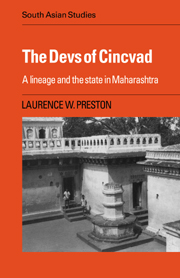Book contents
- Frontmatter
- Contents
- List of figures and tables
- Preface
- List of abbreviations and note on Indian technical usages
- Introduction: an inamdar lineage in Indian history
- PART ONE THE INAMDAR UNDER THE MARATHAS
- PART TWO THE INAMDAR UNDER THE BRITISH
- 3 Introduction to Part Two
- 4 From ritual grandee to state pensioner: varsasans and the Morgav pilgrimage
- 5 An inamdar's domain: Cincvad and the commerce of Pune-Haveli
- 6 The genesis and operation of the Inam Commission
- 7 Claiming an inheritance: the Inam Commission and the Cincvad Samsthan
- 8 Conclusion: an inamdar's rights and the authority of the state
- Bibliography
- Index
- CAMBRIDGE SOUTH ASIAN STUDIES
8 - Conclusion: an inamdar's rights and the authority of the state
from PART TWO - THE INAMDAR UNDER THE BRITISH
Published online by Cambridge University Press: 05 November 2011
- Frontmatter
- Contents
- List of figures and tables
- Preface
- List of abbreviations and note on Indian technical usages
- Introduction: an inamdar lineage in Indian history
- PART ONE THE INAMDAR UNDER THE MARATHAS
- PART TWO THE INAMDAR UNDER THE BRITISH
- 3 Introduction to Part Two
- 4 From ritual grandee to state pensioner: varsasans and the Morgav pilgrimage
- 5 An inamdar's domain: Cincvad and the commerce of Pune-Haveli
- 6 The genesis and operation of the Inam Commission
- 7 Claiming an inheritance: the Inam Commission and the Cincvad Samsthan
- 8 Conclusion: an inamdar's rights and the authority of the state
- Bibliography
- Index
- CAMBRIDGE SOUTH ASIAN STUDIES
Summary
On 27 July 1857 Benjamin Disraeli stood in the House of Commons to denounce the policies of the East India Company that, he maintained, had led to the recently reported disturbances in India. The Company was, he told the House, attacking the sanctity of property in India by establishing inquiries into the title of rent-free lands. In its arrogance the Company was questioning the validity of inam and jagir ‘as proof of a powerful Government, a vigorous Executive, and a most fruitful source of public revenue.’ This unprecedented course was totally at odds with previous British policy in India: when some tyrant had previously usurped these lands, ‘we came in as vindicators of public right, and we invariably guaranteed the security of property, as in the case of jagheers and enams.’ The end result of the Company's disregard of landed rights was that the British had ‘estranged numerous and powerful classes from that authority which I think on the whole they were disposed to regard with deference.’ Hence, for Disraeli, it was no wonder than India was in revolt.
In this attack on British policy in India Disraeli effectively spelled the end of Company rule and of the Inam Commission (though both would struggle on for a time, heedless of any opposition).
- Type
- Chapter
- Information
- The Devs of CincvadA Lineage and the State in Maharashtra, pp. 238 - 247Publisher: Cambridge University PressPrint publication year: 1989



